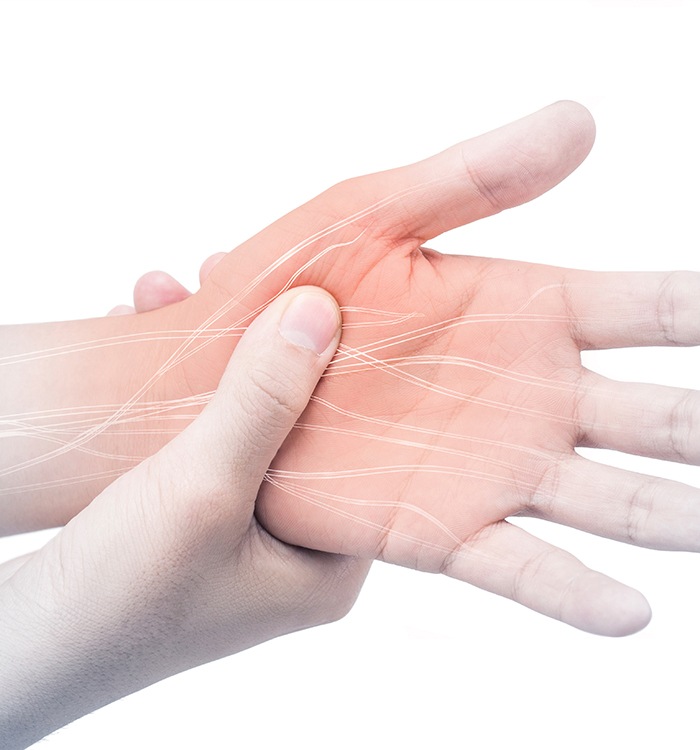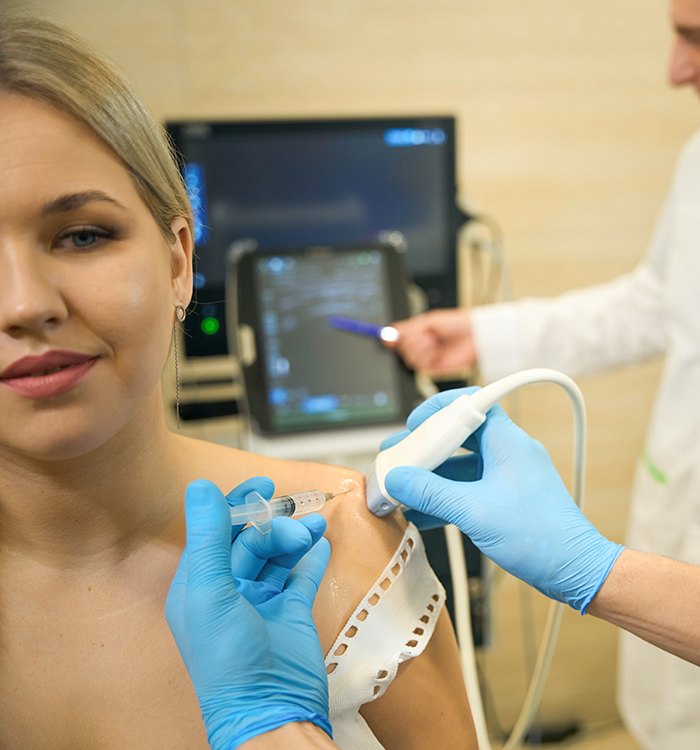
Nerve Hydrodissection Asheville
Fast & Effective Relief from Nerve Pain
Many nerves in the human body originate in the spine. Once they branch out from that area, they have to pass around, between, and even through muscles in order to reach their termination point. Unfortunately, when those muscles become too tight, perhaps due to spasm or an injury, they can squeeze the nerves. This issue, known as a pinched or trapped nerve, can cause pain, weakness, numbness, tingling, and other unpleasant symptoms. How can you find fast and effective relief from this type of nerve pain? Dr. Pinkston and our non-surgical orthopedics team in Asheville may be able to help via a treatment known as nerve hydrodissection.
What Is Nerve Hydrodissection?

The term “nerve hydrodissection” might sound a little scary, but this treatment is nothing to be afraid of! It is both safe and relatively simple. As an added advantage, it also causes little to no discomfort for most patients.
During this procedure, Dr. Pinkston injects fluid into the area around a nerve (NOT into the nerve itself). This helps to ease pressure from the surrounding tissues so that the nerve is no longer being pinched.
Nerve hydrodissection may be used to treat various conditions, such as carpal tunnel syndrome, tarsal tunnel syndrome, sciatica, and various types of pain in the joints, neck, and back.
How Does the Treatment Work?

Nerve hydrodissection treatment usually takes less than one hour. When you arrive in our office, we will escort you to a comfortable treatment area. Then, Dr. Pinkston will use ultrasound guidance to figure out exactly where your injection needs to go. The liquid used is usually D5W, which is basically water with a bit of dextrose in it. The D5W may be combined with a small amount of local anesthetic. In some cases, growth factors are also incorporated into this treatment.
Any discomfort that you may experience is likely to be quite tolerable. Some patients notice temporary numbness or weakness in the treatment area. A tingling or burning sensation may also occur.
You will be able to resume your normal routine immediately after your appointment, though it would be best to avoid strenuous physical activity to allow for tissue recovery. Any soreness from the injection is likely to wear off within 1 – 3 days.
The Benefits of Nerve Hydrodissection

Some of the most outstanding benefits of nerve hydrodissection include:
- The treatment is fast and relatively comfortable.
- For some patients, the results of nerve hydrodissection can last for years. (In other cases, multiple treatments are required for optimum results.)
- Nerve hydrodissection is a much more conservative and affordable solution than surgery.
- You may notice a significant decrease in pain and other symptoms that are related to trapped or pinched nerves.
- Thanks to ultrasound guidance, the treatment is very low-risk.
- No major downtime is required after nerve hydrodissection injections.
Nerve Hydrodissection FAQs
Who Is a Good Candidate for Nerve Hydrodissection?
When you visit our team for a consultation, we will learn about your symptoms, perform an examination, and determine whether or not you are a good candidate for nerve hydrodissection. This treatment may be recommended for you if:
- You are experiencing symptoms related to a trapped or pinched nerve.
- You have already tried more conservative pain relief options, such as medications and exercises, and these have proven to be unsuccessful.
- You are interested in a simple and minimally invasive treatment.
While most people can receive nerve hydrodissection injections, this treatment might not be suitable for you if you have severe nerve damage, advanced diabetes, or certain blood disorders. It should also not be used around open wounds.
Does Medical Insurance Cover Nerve Hydrodissection?
Because nerve hydrodissection is widely accepted in the medical community as a way to address trapped nerves, medical insurance policies frequently cover it. You can get in touch with your insurer to learn whether this procedure will be covered in your unique case. Our team can help you by providing documents that you can submit to your insurance company.
If insurance coverage is not available to you, ask us about other payment options. We are happy to help patients apply for low-interest financing through Varidi.
When Will I Notice Results from Nerve Hydrodissection?
Every patient is unique, so we cannot make any promises about when you will notice results. Many people notice a big reduction in pain within 2 – 3 weeks of their initial appointment. If you require multiple nerve hydrodissection treatments, it might take longer for you to experience optimum results (perhaps 3 – 6 months or so).
Since we want you to enjoy pain relief as soon as possible, we may recommend that your nerve hydrodissection be combined with other conservative treatments that can help to reduce your discomfort.
What if Nerve Hydrodissection Does Not Work?
Nerve hydrodissection is successful in most cases, but if it does not provide sufficient relief for you, we may need to explore other treatment possibilities. For example, you might require additional nerve hydrodissection injections.
Other potential courses of action include:
- Additional diagnostic testing, which can help us determine if factors other than a pinched nerve are contributing to your pain.
- Alternative treatments, such as steroid injections, bracing, or physical therapy.
- Surgical treatments. We typically recommend this only as a last resort because we do not want you to have to face the risks and long recovery time that come with surgery.
What Are the Risks of Nerve Hydrodissection?
This is a low-risk treatment. However, in very rare cases, a patient will develop an infection at the injection site, which could become serious without timely treatment. Some patients may also experience significant swelling.
If you believe you are having a bad reaction to any treatment we administer, contact us right away for assistance.